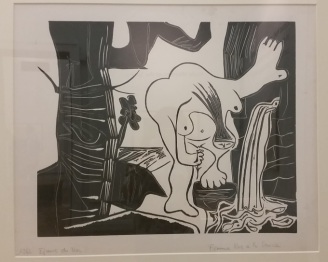Picasso linocuts from the British Museum, Lady Lever Art Gallery, until 8th January 2017, free.
Considering I live on the Wirral, I don’t visit the Lady Lever Art Gallery in Port Sunlight very often. But now they’ve got a Picasso show – a name which they surely know is, happily, going to get people through the door. This is a small but significant collection of linocut prints on loan from the British Museum. They were all made in 1962, 50 years after Picasso had begun turning art on its head with Demoiselles D’Avignon. What is being shown here isn’t revolutionary in terms of style and figuration – indeed it’s pretty much what you’d expect Picasso figures to look like. But even with an artist as famous as he is, there can be new things to learn.
I personally took two interesting things from this show. The first was a glimpse into Picasso’s creative process. These prints were made by cutting every feature, and transferring every colour, onto a single cut block of lino. I remember enough from my degree to know that this is quite unusual, as usually prints are made by combining separate blocks for each colour. To have the confidence in your vision to use just a single surely only comes with the wealth of experience that Picasso had after so many years of work. It also means that the results of the process are beautiful in themselves, and show the development of the idea from start to finish – where the details come in to create the overall effect.

Experiments in colour and style for Still Life Under the Lamp, 1962.

The finished version of Still Life Under the Lamp, 1962.
The second thing was demonstrated by the final room of the show. This exhibition covers the creative development of 3 prints, the final of which is Nude Woman at the Spring.

Nude Woman at the Spring, 1962.
It’s based on a figure from Manet’s Dejuner sue l’herbe and, as before, the figure will fit some of your expectations of a Picasso. But I wondered why he chose to focus on this figure. Then I happened to pick up one of the accompanying books and happened to open it onto a whole section about Picasso’s studies on this painting. In art as in all walks of life it’s fine to admire and respect the past, but we should always be trying to moving things forward and innovate for our generation. Here we see how, even at 80, Picasso was still investigating how to challenge the past and find a fresh perspective, a new story to tell. The same could be said for this exhibition – it’s always nice to learn something new about such a pillar of 20th century art.

I couldn’t have done better than to open at this page of Picasso: Challenging the Past.
As a Wirral resident, it was easy for me to call into the Lady Lever whilst driving between weekend errands. Not something I often do, but a welcome respite from the tedium of the supermarket, and Port Sunlight is a beautiful place for a walk. Consider making the trip next time you’re at a loose end at the weekend. Not least because when you pull up, you’ll notice the banners saying “Art…is within the reach of all of us” – a statement by William Hesketh Lever, and the reason for the very existence of the Lady Lever Art Gallery. After the momentous events of the last week I hope this remains the case, but I must say that I don’t have very much faith that funding will be maintained. Since I’ve been writing this blog I’ve been flattered by the comments from my friends who have told me that they have been inspired to visit galleries. My request to all my readers: please continue to do so. It’s the only way to show the powers that be that, in spite of their indifference, art has a place and purpose in the world that we care about.
